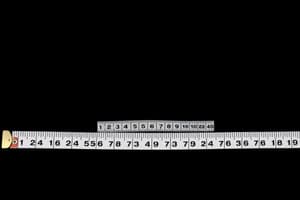Podcast
Questions and Answers
Which of the following are SCALAR quantities?
Which of the following are SCALAR quantities?
- Mass (correct)
- Time (correct)
- Velocity
- Speed (correct)
- Distance (correct)
What is the formula for calculating the weight of an object?
What is the formula for calculating the weight of an object?
Weight = mass × Gravitational field strength
What is the formula for calculating the moment of a force?
What is the formula for calculating the moment of a force?
Moment = force × perpendicular distance from the pivot
The principle of moments states that for a body to be balanced, the total clockwise moment about a point must equal the total anticlockwise moment about the same point.
The principle of moments states that for a body to be balanced, the total clockwise moment about a point must equal the total anticlockwise moment about the same point.
What is the formula for calculating the kinetic energy of an object?
What is the formula for calculating the kinetic energy of an object?
Energy can be created or destroyed.
Energy can be created or destroyed.
What is the formula for calculating the pressure in a liquid?
What is the formula for calculating the pressure in a liquid?
Efficiency is the ratio of useful energy output to total energy input.
Efficiency is the ratio of useful energy output to total energy input.
Flashcards
Speed
Speed
Distance travelled per unit time.
Velocity
Velocity
Speed in a given direction.
Average speed
Average speed
Total distance travelled divided by total time taken.
Acceleration
Acceleration
Signup and view all the flashcards
Scalar quantity
Scalar quantity
Signup and view all the flashcards
Vector quantity
Vector quantity
Signup and view all the flashcards
Mass
Mass
Signup and view all the flashcards
Weight
Weight
Signup and view all the flashcards
Density
Density
Signup and view all the flashcards
Gravitational field strength
Gravitational field strength
Signup and view all the flashcards
Terminal Velocity
Terminal Velocity
Signup and view all the flashcards
Free fall
Free fall
Signup and view all the flashcards
Period of oscillation
Period of oscillation
Signup and view all the flashcards
Resultant Force
Resultant Force
Signup and view all the flashcards
Acceleration of free fall
Acceleration of free fall
Signup and view all the flashcards
Regular solid
Regular solid
Signup and view all the flashcards
Irregular solid
Irregular solid
Signup and view all the flashcards
Measuring volume
Measuring volume
Signup and view all the flashcards
Finding mass
Finding mass
Signup and view all the flashcards
Density of object
Density of object
Signup and view all the flashcards
Floating object
Floating object
Signup and view all the flashcards
Measuring length
Measuring length
Signup and view all the flashcards
Measuring cylinder
Measuring cylinder
Signup and view all the flashcards
Time Interval
Time Interval
Signup and view all the flashcards
Clocks
Clocks
Signup and view all the flashcards
Timer
Timer
Signup and view all the flashcards
Digital timer
Digital timer
Signup and view all the flashcards
Study Notes
Physical Quantities and Measurement Techniques
- Measurement tools include rulers and measuring cylinders for length and volume.
- Digital timers and clocks measure time intervals.
- Average value calculation: sum of all values divided by the number of values.
- Period of oscillation = time taken / number of swings.
- Scalars have magnitude only (e.g., speed, time, mass, energy, temperature).
- Vectors have both magnitude and direction (e.g., velocity, force, weight, acceleration, momentum).
Vectors
- Velocity is a vector because it includes speed and direction.
- Resultant force of two vectors at right angles can be calculated using the Pythagorean theorem.
Mass and Weight
- Mass is the amount of matter in an object.
- Weight is the gravitational force on an object with mass.
- Weight = mass × gravitational field strength (w = mg).
- Gravitational field strength is force per unit mass (equivalent to acceleration of free fall).
- Mass and weight can be compared using a balance.
Density
- Density is mass per unit volume (p = m/v).
- How to determine density in regular solids: measure its length, width, height, calculate volume, find the mass, and perform p=m/v calculation.
- For irregular solids : place the object into a measuring cylinder partially filled with water, record the increase in water level to determine volume, find mass via a balance - then perform p=m/v calculation.
Motion
- Speed is distance travelled per unit time.
- Velocity is speed in a specific direction.
- Average speed = total distance travelled / total time taken.
- Acceleration is change in velocity per unit time (a = Δv/Δt).
- A steeper line on a distance-time graph indicates higher speed.
- A falling object without air resistance accelerates at constant rate, its speed increases steadily.
- Air resistance increases with speed of a falling object, eventually balancing the weight.
- Terminal velocity is the constant speed reached by a falling object when air resistance equals weight.
Forces
- Forces can change an object's size and shape.
- Spring constant is force per unit extension.
- Limit of proportionality: force-extension relationship is linear until the limit of proportionality is reached.
- Resultant force of forces in a straight line is the sum of the forces (add them algebraically).
- Newton's Second Law :Force = mass × acceleration.
- Motion in circular path is due to a perpendicular force.
- Momentum = mass × velocity.
Turning Effects of Forces
- Moment of a force is the turning effect, Moment = force × perpendicular distance from the pivot.
- Principle of moments: total clockwise moment =total anticlockwise moment for a balanced body.
- Equilibrium:no resultant force, no resultant moment.
Momentum
- Impulse is the change in momentum, and is force × time interval
- Momentum is a vector .
- The principle of conservation of momentum states that the total momentum of a system remains constant if no external forces act.
Energy
- Energy can be kinetic, gravitational potential, chemical, elastic, nuclear, electrostatic or internal (thermal).
- Energy transfers occur during events, by forces, electricity, heating, waves.
- Energy cannot be created or destroyed; only transferred from one form to another, or to different locations.
- Sankey diagrams display energy transfers.
Energy Resources
- Various sources like fossil fuels, water (tidal, waves), geothermal, nuclear fuel, solar, wind.
- Some sources are renewable; others are not.
- Efficiency is a measure of how much of the input energy is converted into useful energy output.
- Power is energy transferred per unit time.
Pressure
- Pressure = force/area; pressure in liquid is the weight per unit area at a depth, P = p g h
- Pressure in real life scenarios include standing on a floor, pushing a door, etc.
- Pressure unit is Pascals (Pa).
Studying That Suits You
Use AI to generate personalized quizzes and flashcards to suit your learning preferences.




